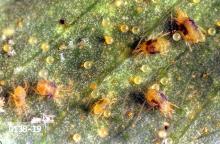Tetranychus urticae
Pest description and crop damage These mites are about 0.5 mm long, have eight legs, and are light tan or greenish with a dark spot on each side. Spider mites feed by sucking the contents out of leaf cells, causing a mottling, stippling and bronzing of the leaves. Their feeding reduces plant vigor and may cause leaves to turn brown and drop.
Biology and life history Mites overwinter as females under loose bark or organic debris at the base of host plants, and on weeds. In the spring, they emerge, disperse, and lay eggs on the leaves. Eggs hatch into larvae in a few days. There may be multiple generations per year. The twospotted spider mite is a warm-season mite, and the greatest activity occurs under warm conditions. Depending on the temperature, a complete generation may require one to three weeks. In the fall, adults cease feeding and migrate to overwintering sites.
Scouting and thresholds Infestations usually begin on lower leaves of plants, then progress upwards. Inspect the oldest leaves first for stippling; webbing and the mites themselves can be found on the underside of leaves.
Management-biological control
Rain and cool temperatures tend to suppress mite populations. Considerable natural control is provided by lady beetles and minute pirate bugs (Orius spp.). Predatory mites such as Typhlodromus spp., or Neoseiulus fallacis (syn. Amblyseius fallacis) and spider mite destroyers (Stethorus spp.) are also effective at managing populations of spider mites and may be purchased and released.
Management-cultural control
Avoid early season applications of insecticides that reduce populations of beneficial insects. Spider mite infestations are favored by dry, dusty conditions, so avoid creating these problems and stressing the plants. Mites can be hosed from plants with a strong stream of water. Excessive nitrogen fertilization may cause population buildup.
Management-chemical control: HOME USE
- azadirachtin-Some formulations are OMRI-listed for organic use
- horticultural oils
- plant essential oils (rosemary, thyme)-Some formulations are OMRI-listed for organic use.
- sulfur-Some formulations are OMRI-listed for organic use.
Management-chemical control: COMMERCIAL USE
- abamectin (Abamex) at 0.009 to 0.019 lb ai/A. PHI 28 days. Gooseberry only. Do not apply during bloom. Restricted use pesticide.
- acequinocyl (Kanemite) at 0.3 lb ai/A. PHI 7 days. Gooseberry only. Controls adults, larvae, nymphs and eggs.
- azadirachtin (Ecozin and other brands)-Consult label for rate. PHI 0 days. Some formulations are OMRI-listed for organic use.
- bifenazate (Acramite and others) at 0.375 to 0.50 lb ai/A. PHI 14 days. Gooseberry only. Also allowed in non-bearing currants (PHI 365 days). Controls adults, larvae and nymphs, and some activity on eggs.
- bifenthrin (Brigade 2EC and others) at 0.08 to 0.10 lb ai/A. PHI 1 day. Hazardous to bees. Restricted use pesticide.
- etoxazole (Stifle' WP) at 0.09 to 0.135 lb ai/A. PHI 14 days. Gooseberry only. Controls eggs and young mites only; not adult mites. One application allowed per season.
- fenazaquin (Magister) at 0.30 to 0.48 lb ai/A. PHI 7 days. Hazardous to bees.
- fenpropathrin (Danitol 2.4EC) at 0.2 to 0.30 lb ai/A. PHI 21 days. Do not exceed 0.8 lb ai/A per season. Do not apply during bloom. Hazardous to bees. Restricted use pesticide.
- fenpyroximate (FujiMite SC) at 0.105 lb ai/A. PHI 1 day.
- hexythiazox (Onager and other brands) at 0.09 to 0.1875 lb ai/A. PHI 7 days. Gooseberry only. Controls eggs, larvae and nymphs only; does not control adult mites. Do not exceed one application per crop season.
- horticultural oil (several brands)-Consult label for rates. Apply as a dormant spray in early season before buds open. Some formulations are OMRI-listed for organic use.
- insecticidal soap (M-Pede and other brands)-Consult label for rate. PHI 0 days. Some formulations are OMRI-listed for organic use.
- pyridaben (Nexter) at 0.2 to 0.5 lb ai/A. PHI varies by label. Gooseberry only. Do not apply during bloom.

